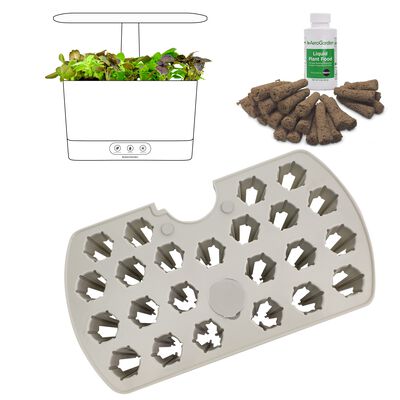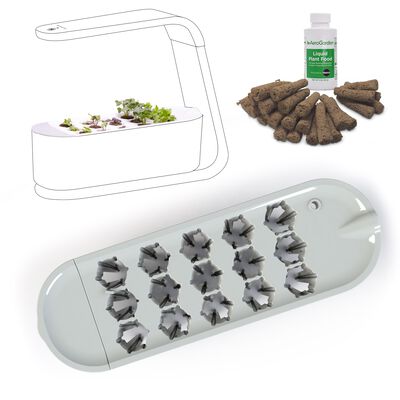
Getting Started: Container Gardens, Raised Beds, and In-Ground Gardening
Starting plants from seeds in an AeroGarden is simple but starting a new garden is a bit more challenging.
Site Selection
Sun exposure
A gardener can amend or replace soil, ensure perfect soil chemistry, and provide an ideal amount of water, but the garden will not grow well without sufficient sunlight. Vegetable and herb plants require at least six hours of direct sunlight daily to produce healthy, compact foliage and abundant flowers and fruit.
An ideal location receives sunshine from sunrise until early afternoon, and then gets a bit of shade in the hottest part of the afternoon. Lightly filtered sunlight, as with sunlight shining through a high, open tree canopy, may be sufficient. South or west facing slopes should be used with caution since they tend to build excessive heat and dry out quickly.

Avoid planting beneath dense tree canopies, between closely spaced buildings, or on north-facing balconies and patios where the sun rarely shines. Some marginally sunny areas can be improved for gardening by selectively pruning low branches. If no sunny location is available at home, consider joining a community garden.
Size
Outdoor gardens thrive even in the smallest spaces. Balconies, patios, rooftops, and decks make ideal settings for container gardens. These areas lend themselves especially well for vertical gardening strategies like hanging baskets, trellising, and tower gardens. Medium and large spaces greater than 500 square feet work best with either raised beds or in-ground gardens.
Conveniences
An important consideration before breaking ground is the location’s convenience factor. Enthusiasm and energy may wane over time if it’s too difficult to water, deliver garden supplies, or dispose of debris. Also keep in mind, others who use the space may not be enthusiastic about gardening. During the planning phase, ask yourself the following questions:
- Where is the closest hose outlet?
- Where will garden tools be stored?
- How difficult is access to deliver or remove supplies or debris?
- Is there a clear path between the garden and the kitchen (for harvesting veggies and herbs)?
- Will the garden be overlooked and forgotten because it is too out-of-the-way?
- If I plant a garden here, will it be cumbersome or intrusive for neighbors, guests, or family members?
- Will it be safe from pets and pests?
Answers to these questions may lead to improvements to make the area work even better, or they could be deal breakers. Either way, it’s important to work through these issues before investing the physical work of creating the garden.
Garden Soil vs Potting Soil
After settling on the location, the next step is to provide growing space. That means soil improvement, either by filling containers or amending the soil in the ground. Although there is broad flexibility among the various kinds of bagged soils that are available at garden centers, two categories bear mentioning here: garden soil and potting soil. Both are manufactured products, but each is ideal for different applications.
Garden soil
Garden soil is formulated as an amendment for garden beds, both in-ground and raised beds. Some garden soils, like Miracle-Gro Raised Bed Soil, may be used to fill raised beds without mixing. One cubic foot will cover four square feet with a three inch layer. Measure the square footage (length x width) of the garden plot, and divide by four to determine how many cubic feet of garden soil will be needed.
To amend a garden bed, apply a three inch layer of bagged garden soil and dig or rototill it into the top three inches of native soil. It improves the ground for gardening by loosening heavy clay to improve drainage, and increasing organic content of sand for better water retention. In all native soil types garden soil increases the efficiency of water and fertilizer, and reduces runoff.

Potting soil
Potting soil, also called potting mix, container soil, or container mix, provides an ideal growing environment for potted plants. It does not need to be mixed with anything, and includes a light dose of plant food. Many are considered “all purpose,” but some of these products are labeled for cacti and succulents, African violets, orchids, or other specialty plants. For growing veggies and herbs in outdoor containers, a high-quality potting soil like Miracle-Gro Performance Organics All Purpose Container Mix is the best choice.
The most challenging part of using potting soil is knowing how much to buy. Potting soil bag sizes are measured in quarts, while containers are measured in inches. Here’s a quick breakdown of the approximate soil volumes of the most common container garden pot sizes:
- 10-inch pot = 5 quarts
- 12-inch pot = 12 quarts
- 14-inch pot = 18 quarts
- 16-inch pot = 22 quarts
- 20-inch pot = 28 quarts
- 24-inch pot = 36 quarts
How to Create a New Garden Bed in the Ground
Prepare for an in-ground garden by removing existing weeds and vegetation, and adding soil amendments to improve the structure. There are different ways to perform both of these tasks, depending on your timeline and physical ability.
Remove existing vegetation
The fast, labor intensive way to remove vegetation is to dig it out with a spade or sod cutter. This method leaves weed seeds and living roots behind, both of which can resprout. The slow, easy way is to smother vegetation with a plastic tarp for three to 12 months. Some seeds and roots may be left behind to regrow, but far fewer than the cutout method.
Add garden soil
Incorporate garden soil into the top three to six inches of native soil with a garden spade or rototiller. An alternative is to apply a three to six inch layer of raised bed soil to the vegetation-free surface, and plant it without combining with native soil. The incorporation method is best for quickly fixing compacted soils, while the non-incorporation method can help suppress weed regrowth.
There are plenty of ways to get into outdoor gardening, with the biggest limitation being sun exposure. In sunny spaces, container gardens, raised beds, and traditional gardens can flourish. A convenient location combined with a little planning and soil preparation is the recipe for gardening success.




